The first time I touched an indigo plant, my world changed. As a textile artist, I fell in love with its magical blue pigment. This pigment connects generations of artisans. Your journey into natural dye cultivation begins here.
Growing an indigo plant is more than just a hobby. It’s about connecting with an ancient art that turns leaves into blue. This guide will help you create your own natural dye garden. You’ll learn how to choose the right indigo species and extract the blue pigment.
If you love gardening, textiles, or eco-friendly crafts, growing indigo plants is for you. It lets you explore ancient coloring techniques. Soon, you’ll learn to care for these amazing plants that create a celebrated natural dye.
Learning about indigo cultivation opens up a world of blue possibilities. You’ll discover how to turn seeds into a palette of blues. Get ready for an inspiring journey into natural dyeing.
Table of Contents
What is the Indigo Plant?
Indigo plants are amazing botanical wonders with a rich history. The indigofera tinctoria is a special species that has changed how we make textiles and celebrate traditions for thousands of years. These plants make an incredible blue dye that has amazed people all over the world.
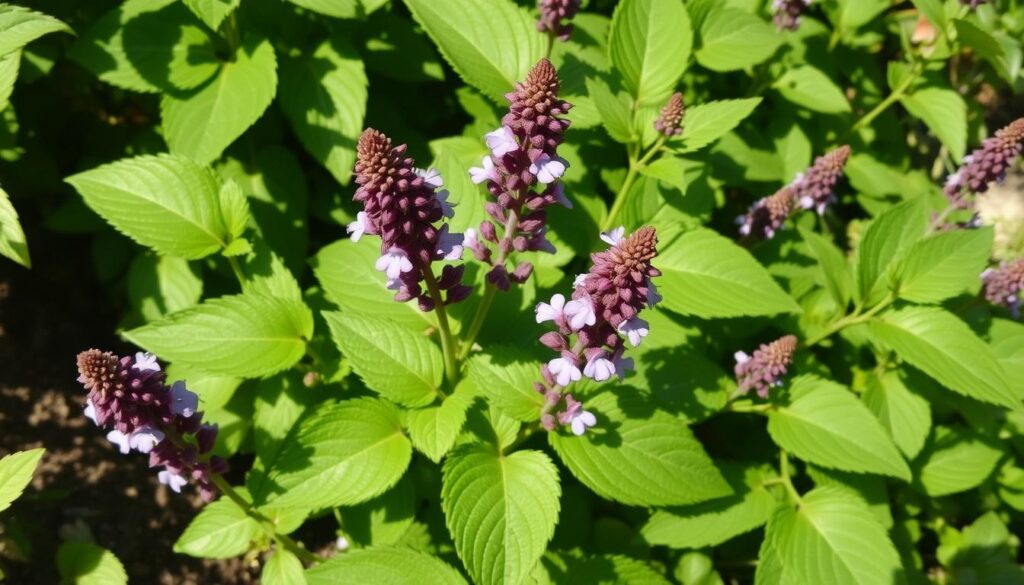
Introduction to Natural Blue Pigments
Organic pigments from Indigo-Plants have been key in human creativity and trade. The indigo species is part of the Fabaceae family, with many varieties grown globally. These plants are not only beautiful but also very useful, with uses beyond just dyeing textiles.
Historical Significance
The history of indigo is closely linked to global trade and cultural exchange. Key moments include:
- Indigo-dyed textiles found in the Indus Valley Civilization (2500-1500 BCE)
- Important role in colonial trade networks
- Symbol of resistance during India’s fight for independence
“Indigo is more than a color; it’s a testament to human resilience and creativity.” – Traditional Textile Artisan
Uses Beyond Dying
While making blue dye is its main use, indigofera tinctoria has many other uses:
- Traditional medicine
- Natural pesticide development
- Ecological sustainable textile practices
| Application | Description | Cultural Significance |
|---|---|---|
| Textile Dyeing | Primary blue dye production | Global textile heritage |
| Medicinal Use | Herbal remedy preparation | Traditional healing practices |
| Ecological Agriculture | Natural pest control | Sustainable farming methods |
Learning about Indigo-Plants shows their big impact on human culture, design, and the environment.
Types of Indigo Plants to Grow
Exploring indigo cultivation opens a world of botanical coloring. Not all Indigo-Plants are the same. Each variety has its own traits for your natural dye garden. Knowing the types helps you pick the right plants for your space and dye needs.

Indigofera tinctoria: The Classic Indigo
Indigofera tinctoria is the most famous indigo plant for dyeing. It comes from India and has been used for centuries. It’s known for:
- Thrives in warm climates
- Produces high-quality blue pigment
- Requires full sun exposure
- Grows best in well-drained soil
Polygonum tinctorium: Japanese Indigo
Polygonum tinctorium, or Japanese indigo, is great for cooler areas. It’s a flexible choice for indigo cultivation. It’s known for:
- Better cold tolerance
- Faster growth cycle
- Compact plant structure
- Rich blue pigment production
Other Notable Varieties
While Indigofera and Polygonum are common, there are other varieties too. Wild indigo and tropical indigo species are interesting. They offer different ways to explore botanical coloring.
“In the world of natural dyes, indigo remains the most mystical and captivating color.” – Natural Dye Expert
Ideal Growing Conditions for Indigo
To grow a successful Indigo-Plant, you need to know its specific needs. Whether you’re growing it for natural dye or garden beauty, the right conditions are key.

Starting with the best environment is crucial for these plants. Each care step helps them grow well and produce natural dye.
Soil Requirements for Indigo
Your Indigo-Plant loves well-draining, fertile soil. It should have:
- pH level between 5.5 and 7.0
- Rich in organic matter
- Loamy texture for excellent drainage
- Moderate nutrient content
Sunlight Needs
Indigo-Plants love the sun and need full sun. The ‘Last Dance’ false indigo is very adaptable. Here’s what to aim for:
- 6-8 hours of direct sunlight daily
- Protection from intense afternoon heat
- Consistent light exposure
Watering Guidelines
Watering is key for a healthy Indigo-Plant. They need steady moisture, especially when growing fast:
- Water deeply but infrequently
- Allow soil to dry slightly between waterings
- Avoid waterlogging
- Reduce watering during dormant seasons
“The key to successful indigo cultivation lies in understanding and mimicking its natural habitat.” – Traditional Gardening Wisdom
By following these tips, you’ll create the perfect spot for your indigo plant. It will thrive and might even give you vibrant natural dye for your projects.
How to Start Indigo Seeds
Growing indigo from seeds is a fun journey for those into organic pigments and green gardening. It starts with picking the right seeds, getting them to sprout, and moving them to a new home.
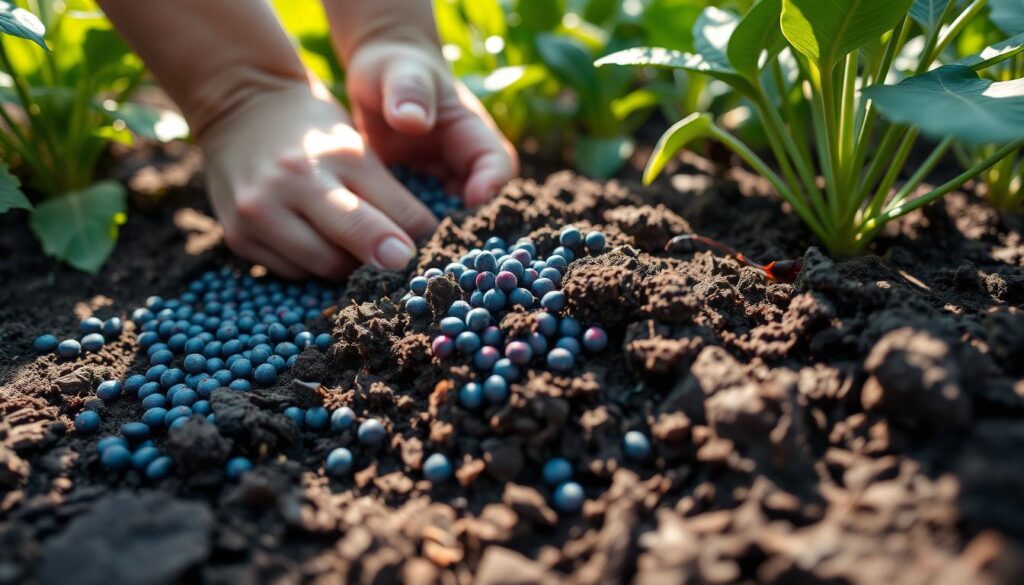
Selecting Quality Indigo Seeds
Start by picking seeds from trusted places that focus on organic plants. Look for seeds that are likely to grow well in your area.
- Purchase from reputable seed suppliers
- Check seed packet for germination percentage
- Verify seed age and storage conditions
Germination Secrets
Indigo seeds need the right conditions to grow. Make their growing space as close to nature as possible for the best results.
| Germination Parameter | Recommended Conditions |
|---|---|
| Temperature Range | 70-80°F (21-27°C) |
| Germination Time | 7-14 days |
| Seed Depth | 1/4 inch deep |
Transplanting Your Seedlings
Once your indigo seedlings are strong enough, it’s time to move them outside. Wait until they have a few true leaves and the weather is safe.
- Gradually expose seedlings to outdoor conditions
- Choose a sunny location with well-draining soil
- Space plants 18-24 inches apart
“Patience and careful attention transform tiny seeds into vibrant Indigo-Plants.” – Gardening Wisdom
By following these steps, you’ll grow beautiful indigo plants. They’ll be ready to make stunning organic pigments for your projects.
Caring for Your Indigo Plants
Growing Indigo-Plants needs careful attention for healthy growth and good natural dye. Your Indigo-Plant must get consistent care to thrive. This care ensures vibrant leaves for dye extraction.
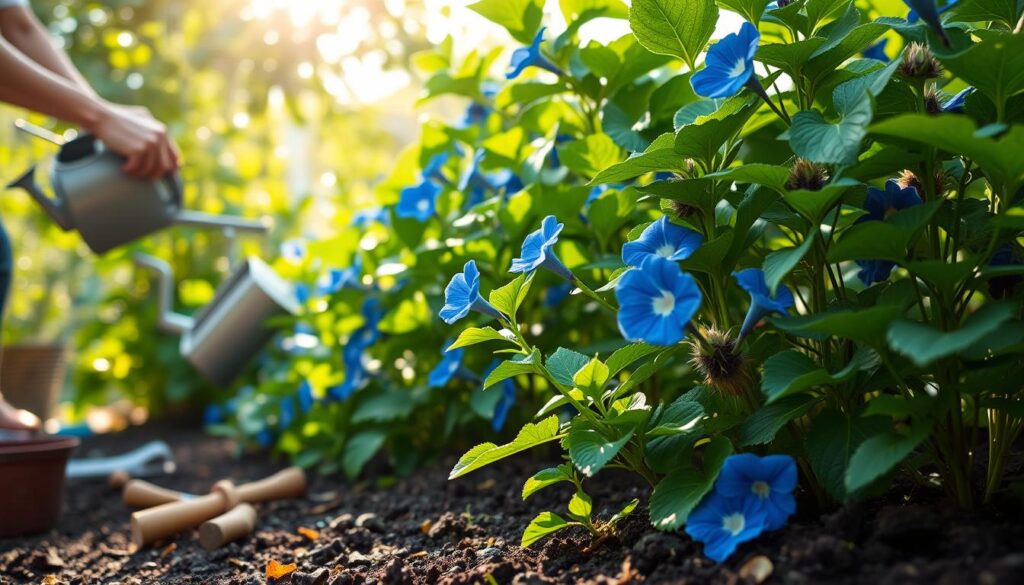
Fertilizing Tips for Robust Growth
Give your Indigo-Plant the right nutrients for growth. Use an organic fertilizer with balanced nutrients for leaf development. Here are some fertilization tips:
- Apply slow-release organic fertilizer in early spring
- Use compost to enhance soil nutrition
- Avoid over-fertilizing, which can reduce dye quality
Identifying Pests and Diseases
Your Indigo-Plant may face some challenges. Look out for common issues like:
- Aphids clustering on young leaves
- Spider mites in hot, dry conditions
- Fungal diseases during high humidity
“Preventative care is the best strategy for maintaining healthy Indigo-Plants.”
Pruning and Maintenance Techniques
Regular pruning makes your Indigo-Plant bushier and increases leaf production. Strategic trimming helps maintain plant health and productivity. Cut back stems by one-third during the growing season for robust development.
By following these care techniques, your Indigo-Plants will stay strong. They’ll be ready to provide high-quality leaves for natural dye production.
Harvesting Indigo for Dye
Growing indigo for blue dye is a precise process. The most important part is harvesting the leaves. These leaves will turn into the vibrant natural color you want.
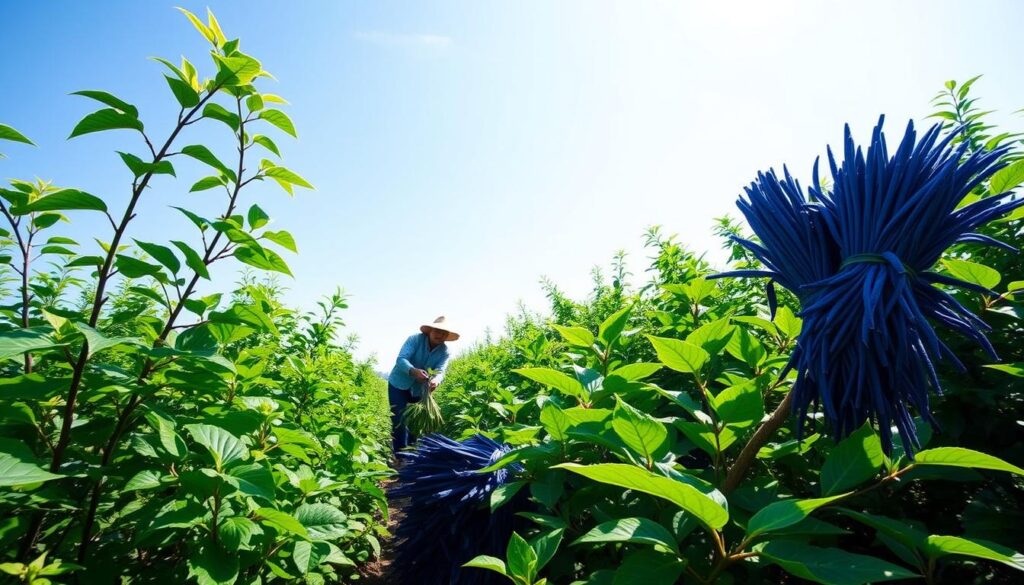
Timing Your Harvest
The best time to harvest Indigo-Plants is 60-90 days after planting. Look for these signs:
- Plants reaching full bloom
- Leaves displaying deep green color
- Maximum leaf volume achieved
Proper Harvesting Techniques
Follow these steps for harvesting indigo:
- Use sharp, clean pruning shears
- Cut stems 6 inches above ground level
- Harvest during morning hours when leaves are most hydrated
- Wear protective gloves to prevent skin irritation
Storing Your Harvest
Proper storage is key for dye quality:
| Storage Method | Duration | Temperature |
|---|---|---|
| Fresh Leaves | 24-48 hours | 35-40°F |
| Dried Leaves | 6-12 months | Cool, dark place |
“Precision in harvesting transforms simple leaves into a centuries-old textile art form.”
Success in indigo cultivation comes from careful observation and gentle handling.
Extracting Dye from Indigo
Dye extraction from indigo-plants is a fascinating process. It turns vibrant green leaves into deep blue pigments. Your journey into organic pigments starts with learning how to transform plant material into stunning colorants.

The art of dye extraction needs patience, skill, and careful technique. Whether you’re a craft enthusiast or a natural dye professional, learning the right methods is key. It helps you create beautiful blue hues from your indigo harvest.
Traditional Extraction Methods
Traditional dye extraction techniques have been practiced for centuries. Here’s how indigenous artisans created their blue pigments:
- Harvesting fresh indigo leaves at peak maturity
- Soaking leaves in water to initiate fermentation
- Allowing natural oxidation to develop blue pigments
- Separating solid plant material from liquid extract
Modern Extraction Techniques
Contemporary dye extraction methods have made the traditional process easier. Modern techniques often use scientific approaches to improve efficiency and color consistency:
- Using precise temperature controls
- Implementing chemical stabilizers
- Employing specialized filtration systems
- Utilizing advanced oxidation processes
Safety Precautions
“Safety first in dye extraction ensures both quality results and personal protection.”
When working with organic pigments and dye extraction, always prioritize your safety:
- Wear protective gloves and eyewear
- Work in a well-ventilated area
- Use chemical-resistant surfaces
- Keep children and pets away from extraction workspace
With careful technique and respect for the process, you can transform indigo plants into stunning blue dyes. These dyes connect you to centuries of textile artistry.
Using Indigo Dye in Crafts
Exploring textile dyeing with indigo opens a world of creativity. The deep blue of indigo has amazed artists for centuries. It turns simple fabrics into stunning art.

Fabric Dyeing Methods
Understanding indigo dyeing techniques is key. Natural fibers like cotton, linen, and silk work well. You can use several methods:
- Immersion dyeing for solid color coverage
- Gradient techniques for subtle blue variations
- Resist dyeing for intricate patterns
Painting with Indigo
Indigo isn’t just for fabric dyeing. Artists use it for painting, creating watercolor-like effects. Mixing indigo with other pigments makes rich colors.
Creating Indigo Shibori
Shibori, a Japanese technique, offers detailed indigo designs. It involves folding, binding, or stitching fabric. This creates amazing patterns.
| Shibori Technique | Pattern Characteristics |
|---|---|
| Itajime | Geometric shapes through folding |
| Arashi | Diagonal striped patterns |
| Kumo | Spiderweb-like circular designs |
“Indigo is not just a color, it’s a journey of creativity and tradition.” – Traditional Textile Artist
Companion Plants for Indigo
Creating a thriving indigo garden needs careful planning. Choose plants that help indigo grow, keep pests away, and stay healthy. This makes your natural dye garden better.
Companion planting boosts your indigo’s growth. It’s a gardening trick that makes your garden stronger and more productive. By picking the right plants, you can make your garden better.
Enhancing Growth with Companions
Think about plants that help indigo grow:
- Nitrogen-fixing legumes to improve soil quality
- Aromatic herbs that naturally repel harmful insects
- Flowering plants that attract beneficial pollinators
Suggested Plant Pairings
Good friends for indigo plants are:
| Companion Plant | Benefit to Indigo |
|---|---|
| Marigolds | Pest deterrence |
| Beans | Soil nitrogen enrichment |
| Lavender | Attracts pollinators |
| Chamomile | Improves essential oil production |
Benefits of Companion Planting
Adding companion plants to your garden has many perks. Strategic planting fights pests, makes nutrients available, and balances your garden. This helps indigo plants grow well.
“In nature, no plant grows alone. The same principle applies to your garden.” – Gardening Wisdom
With smart companion planting, you’ll have a better indigo garden. It will be more sustainable and productive, just like nature.
Troubleshooting Indigo Growth Issues
Growing an indigo plant for botanical coloring can be tough. Every gardener faces challenges that test their skills. Knowing common problems helps keep your indigo plants healthy and growing well.
Common Problems and Solutions
Your indigo plant may face several growth challenges. Spotting these issues early can save your project. This way, you can avoid potential failures.
- Yellowing leaves indicate nutrient deficiencies
- Wilting shows improper watering
- Stunted growth comes from poor soil
- Pest infestations harm plant health
Signs of Stress in Plants
It’s important to recognize stress signals in your indigo plant. This keeps it healthy and thriving. Watch for these warning signs:
| Stress Symptom | Potential Cause | Recommended Action |
|---|---|---|
| Leaf Discoloration | Nutrient Imbalance | Adjust soil fertilization |
| Drooping Leaves | Water Stress | Modify watering schedule |
| Slow Growth | Insufficient Sunlight | Relocate plant |
When to Seek Expert Help
Some indigo plant problems need expert help. If your project keeps facing challenges, consider getting advice from:
- Local agricultural extension offices
- Professional botanical gardeners
- Specialized horticultural forums
“Understanding your plant’s needs is the first step to successful cultivation.” – Botanical Experts
Remember, patience and careful observation are key to successfully growing and maintaining your indigo plant.
The Environmental Benefits of Growing Indigo
Growing indigo plants does more than just provide a natural dye. Your garden can become a haven for the environment and support biodiversity.
By growing indigo, you create a home for beneficial insects and pollinators. These small creatures are key to keeping our ecosystems balanced and supporting local wildlife.
Promoting Biodiversity
Indigo plants draw in a variety of beneficial insects, including:
- Honeybees
- Butterflies
- Native pollinator species
- Predatory insects that control garden pests
Sustainable Dye Alternatives
Indigo is a Natural-dye that’s better for the environment than synthetic dyes. It reduces pollution and cuts down on the carbon footprint of textile production.
| Synthetic Dye Impact | Natural Indigo Advantage |
|---|---|
| High chemical usage | Biodegradable process |
| Water contamination | Minimal environmental stress |
| Toxic waste production | Sustainable cultivation |
Eco-Friendly Practices
To get the most out of your indigo garden, try these eco-friendly tips:
- Use organic composting methods
- Practice water conservation
- Avoid chemical pesticides
- Create habitat-friendly garden spaces
“By growing indigo, you’re not just creating a garden, but nurturing an entire ecosystem.” – Sustainable Gardening Expert
Your indigo garden can be a powerful tool for environmental stewardship, transforming a simple plant into a catalyst for ecological harmony.
Expanding Your Natural Dye Garden
After mastering indigo, you’re ready to explore more colors. Your garden can become a canvas of colors, turning your outdoor space into a treasure trove of hues.
Adding more plants will expand your color range and gardening skills. Here are some exciting plants to add to your garden:
- Madder root: Produces rich red tones
- Weld: Creates brilliant yellow shades
- Woad: Generates beautiful blue hues
- Marigold: Offers warm orange and yellow pigments
Planning Seasonal Growth
Plan your garden to have plants ready all year. Choose plants that grow at different times and need different care. This way, you’ll always have colors to dye with.
Learning Resources
Keep learning to grow your skills:
- Specialized botanical coloring workshops
- Online gardening communities
- Expert-authored natural-dye books
- Local horticultural society classes
“Every plant tells a color story waiting to be discovered.” – Natural-dye Enthusiast
Your natural-dye gardening journey is just starting. Be adventurous, try new things, and watch your garden become a colorful laboratory.
Conclusion: Your Indigo Journey Awaits
Starting your indigo plant journey connects you to an ancient art. It turns simple gardens into vibrant art studios. Growing and extracting indigo dye is more than a hobby; it’s a link to sustainable crafting.
Learning about the indigo plant opens a world of creativity. Whether you’re new or experienced, these deep blues inspire your art. Natural-dye techniques are a rewarding way to learn about botanical colors.
Embracing the Process
Patience is crucial when working with indigo. Each plant offers a chance to try new dye techniques. Your garden becomes a place where tradition meets modern creativity.
Keeping a record of your progress is helpful. It shows your growth and motivates you for more.
Joining the Indigo Community
Connect with others who love natural-dye through forums, clubs, and workshops. Sharing your journey builds knowledge and friendships. Your indigo journey is about growing plants and building a community that loves sustainable art.
Sharing Your Results
Show off your indigo-plant successes on social media, at exhibitions, or craft fairs. Your unique dye projects can inspire others. Each piece shares a story of patience, creativity, and nature’s colors.

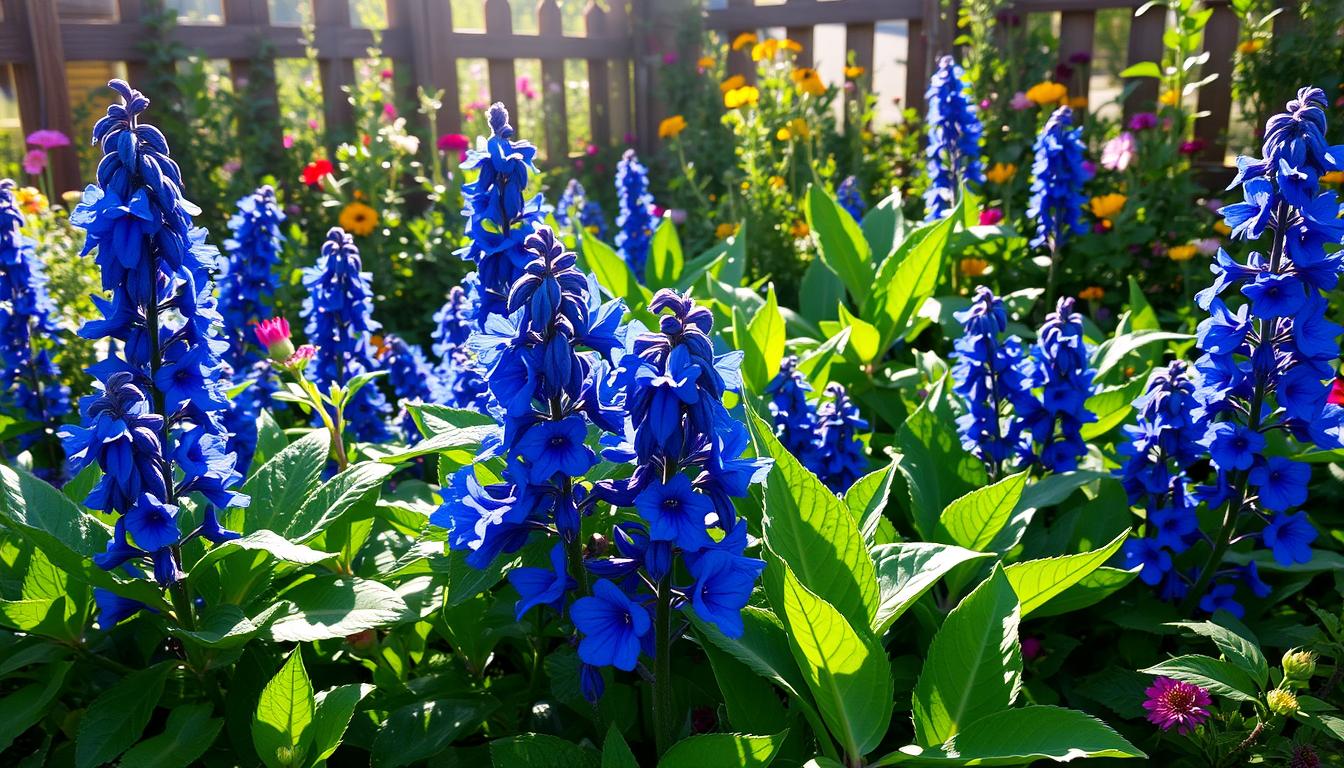


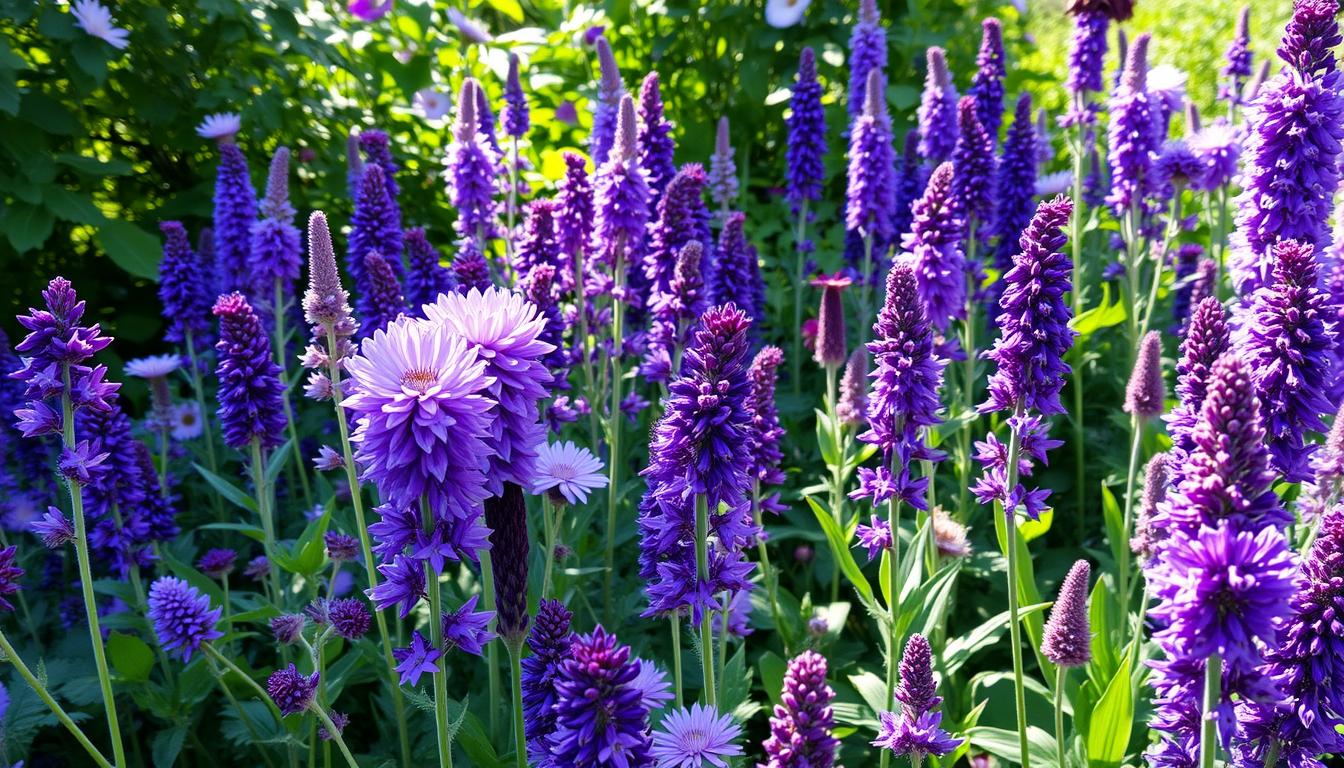
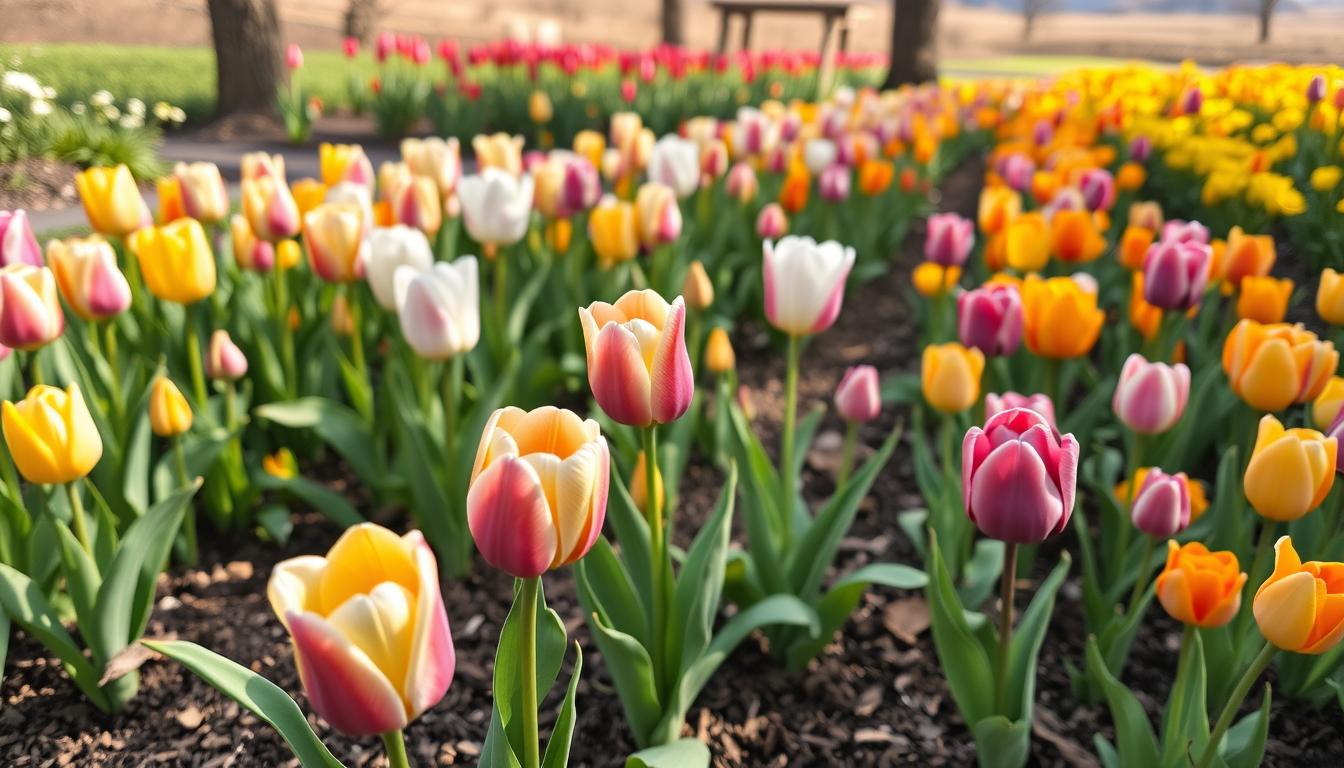
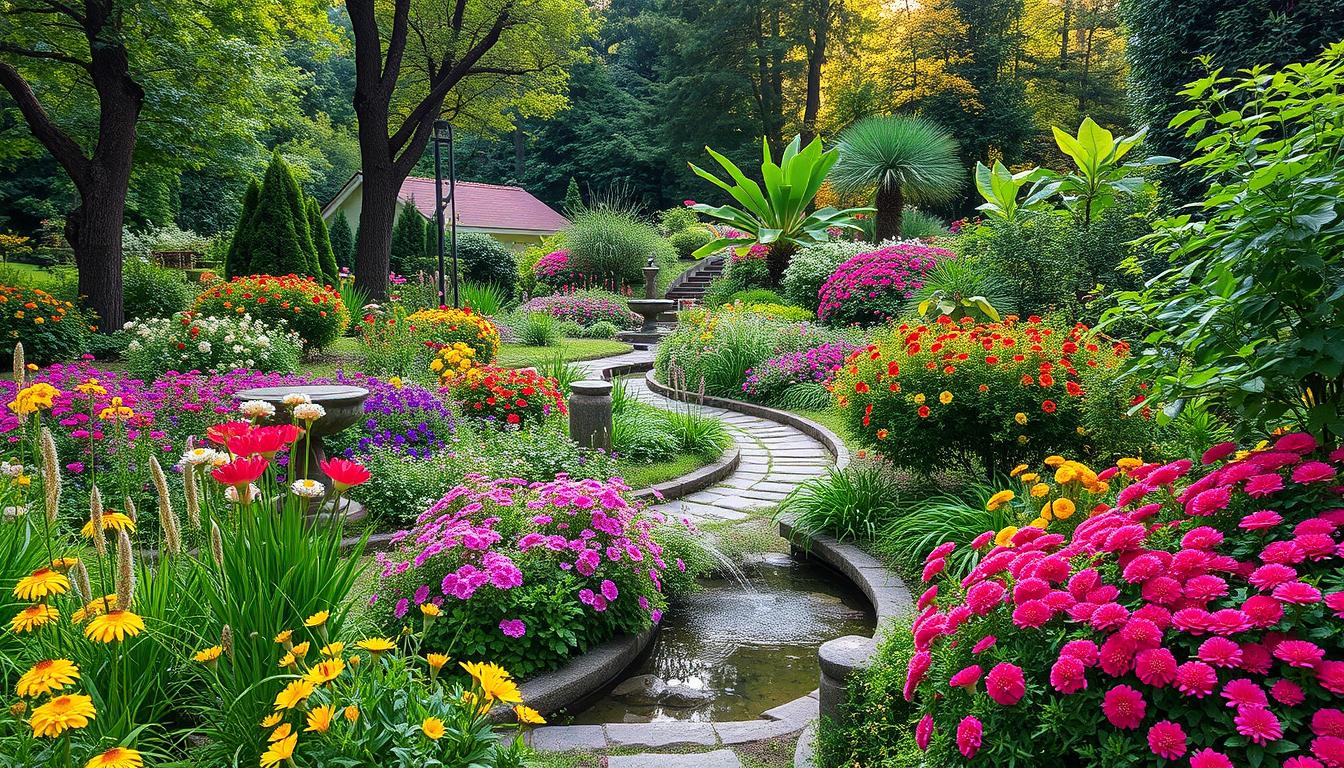
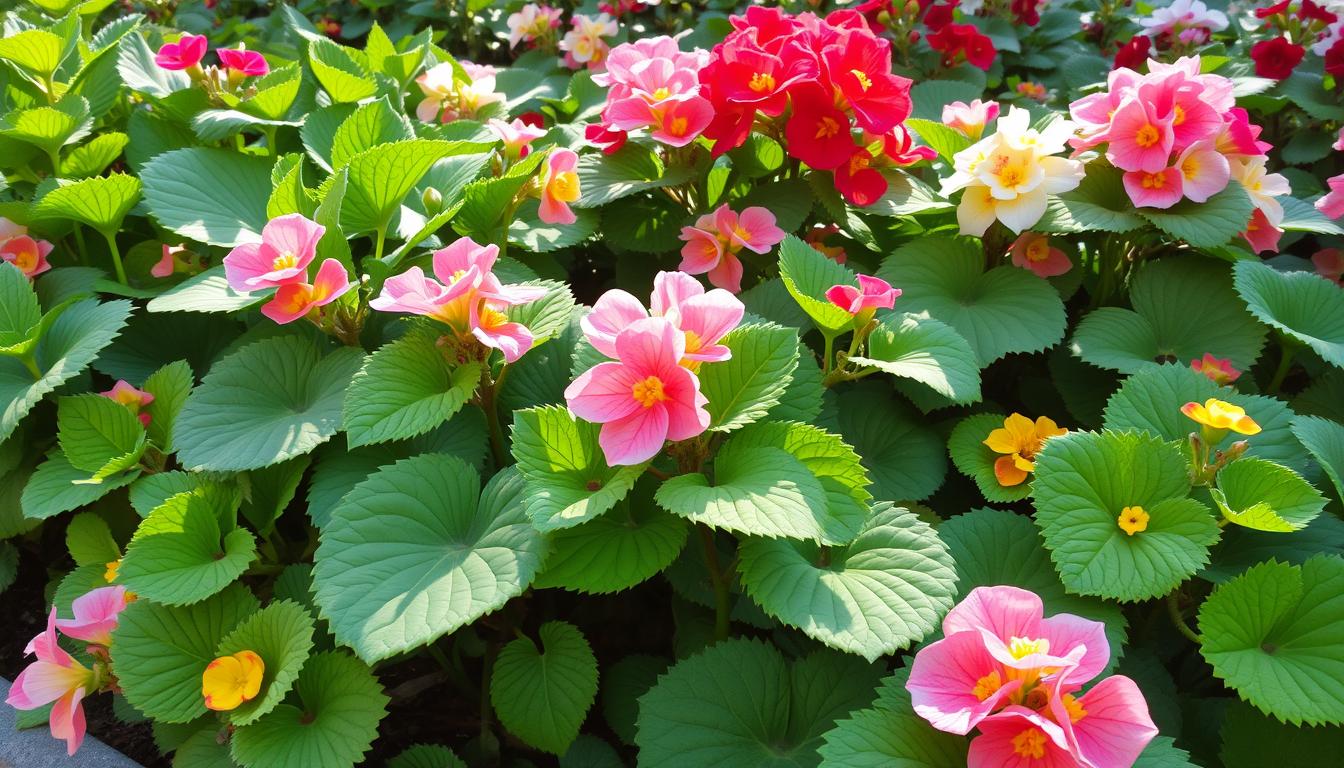
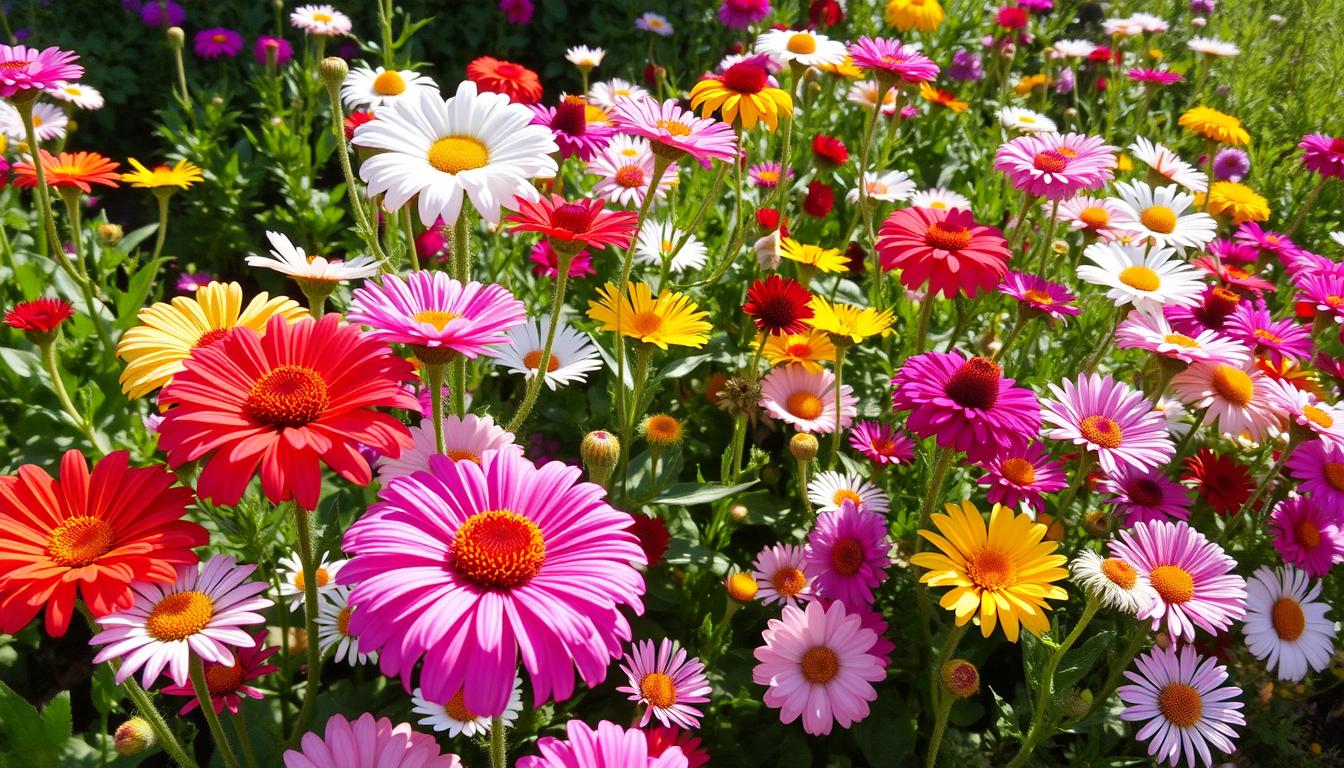
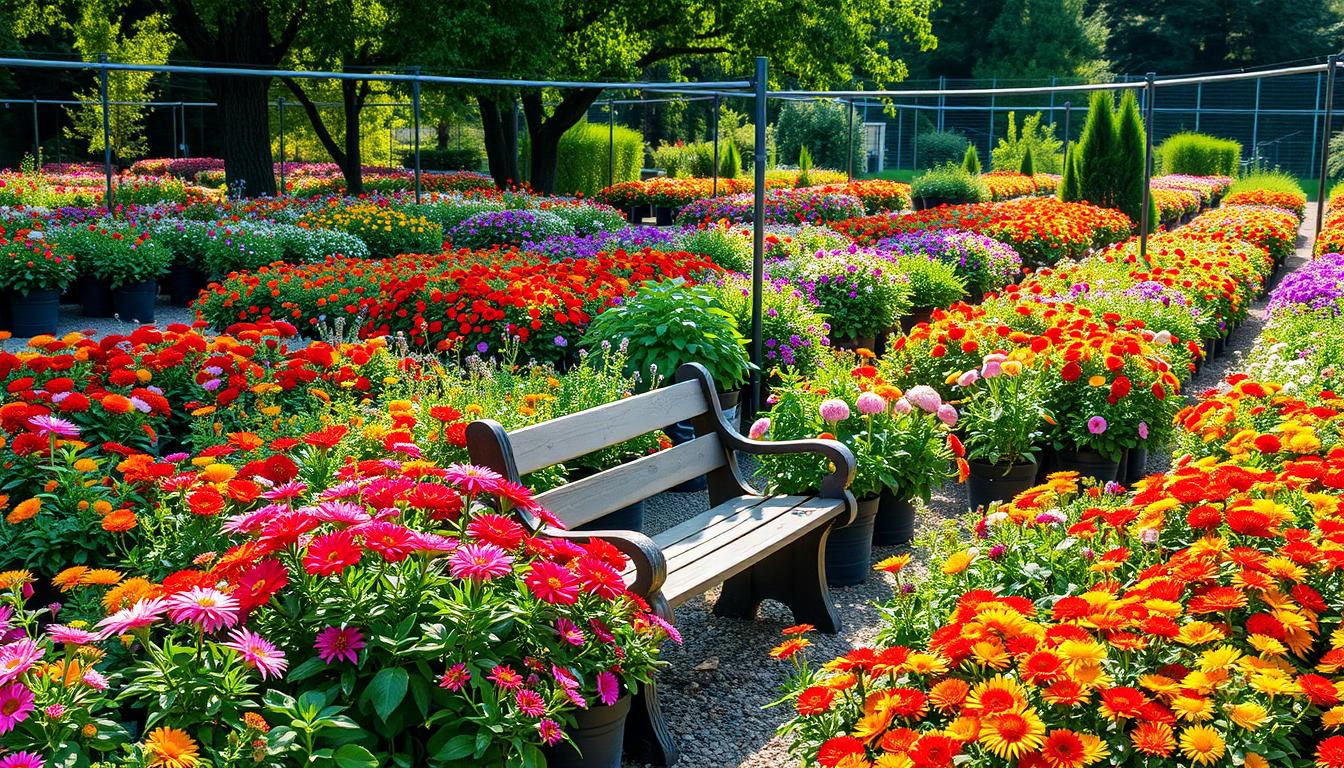
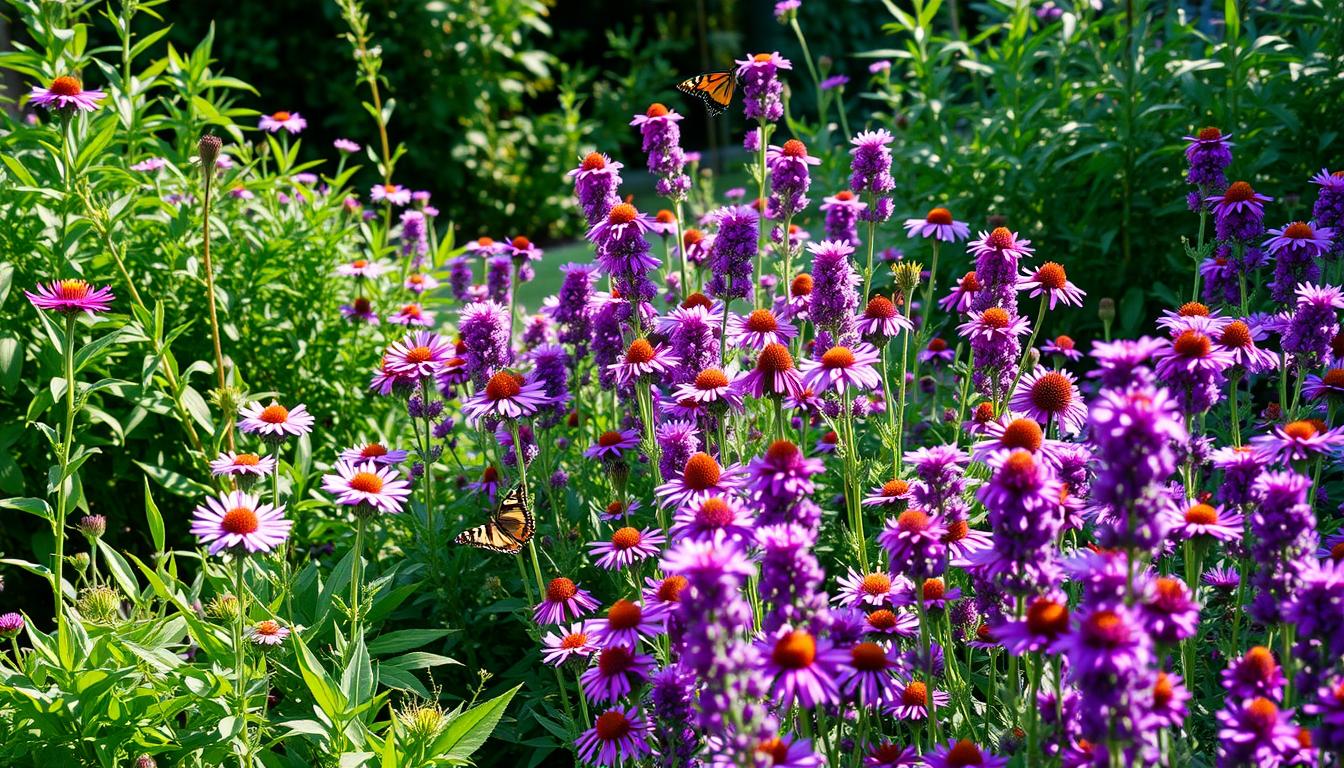
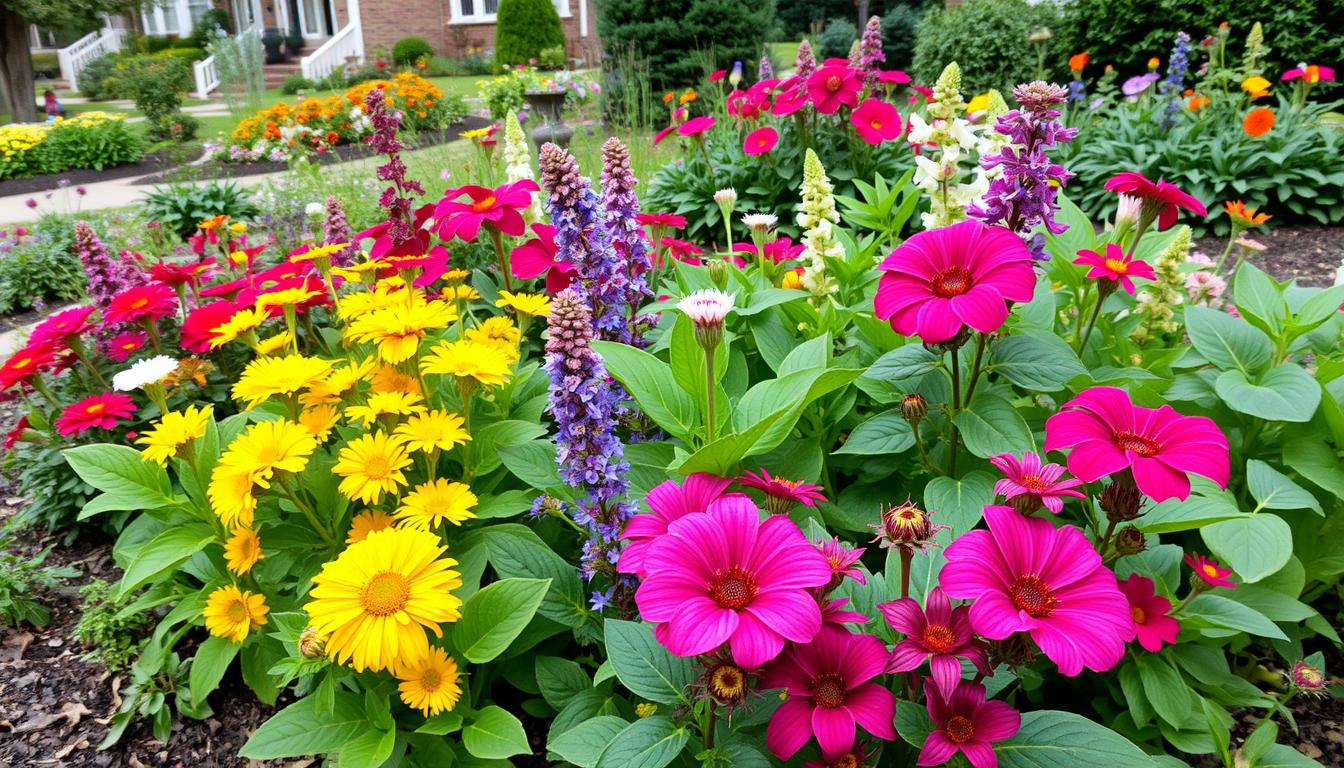
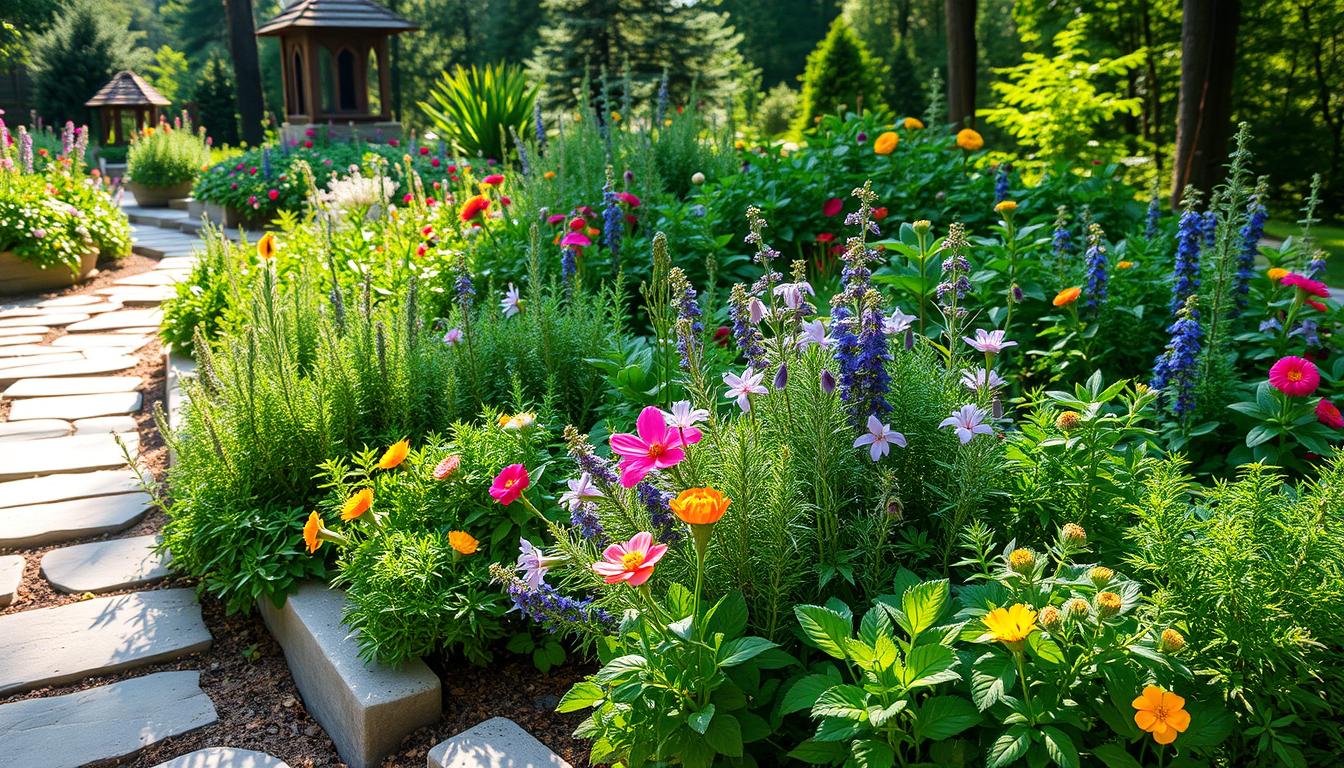
1 thought on “Growing Indigo Plant: Tips for Your Natural Dye Garden”